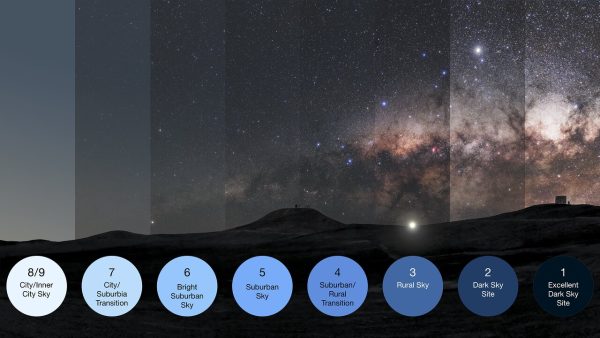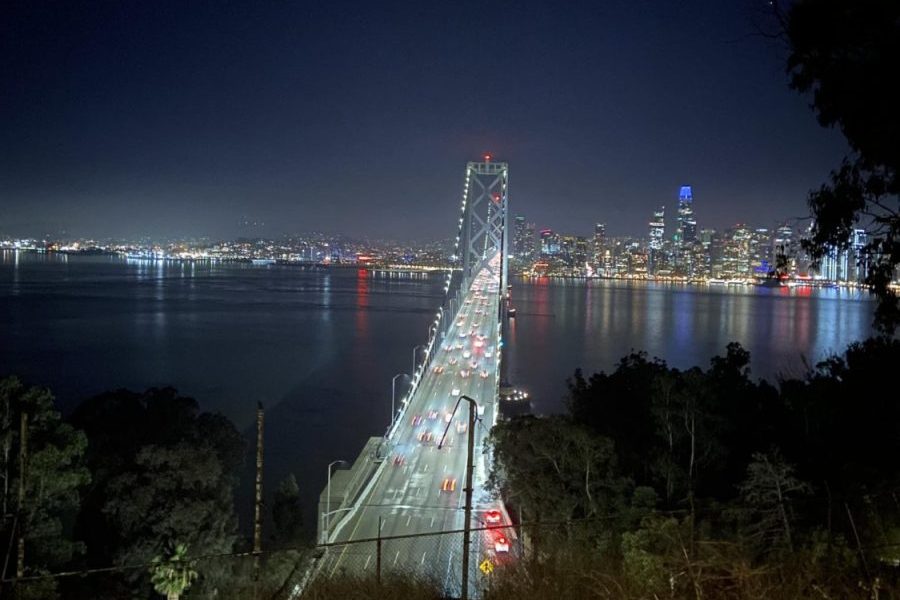Obscured by a veil of artificial light, our night sky is disappearing right before our eyes, and along with it, our ability to see stars and constellations.
The glaring culprit? Light pollution, or “sky glow,” is the brightening of the night sky caused by street lights, residential and commercial lighting, and other man-made sources. In addition, to the dismay of star watchers and astronomers, increased sky glow has severe impacts on human and animal populations.
Alexandre Simoneau is a student in Quebec, Canada, who is pursuing his Ph.D. in an area related to light pollution and has studied the issue for more than eight years. Simoneau is working on a project with Christopher Kyba, who’s the lead author of a renowned study published in 2023 on light pollution. Based on observations by citizen scientists, Kyba found that the night sky got brighter by 9.6% per year from 2011 to 2022, which is equivalent to doubling the sky brightness every eight years.
This is alarming because this rate has sped up immensely since the problem was first recognized in the 1970s. In addition, this increase reveals even greater light pollution than what has been shown by earlier satellite observations, which generally do not pick up light from LED sources and horizontal light.
“There are so many bad lighting practices where light is wasted a lot,” Simonaeu said.
Dark Sky International estimates that at least 30% of all outdoor lighting in the U.S. alone is wasted, mostly by lights that aren’t shielded. That adds up to $3.3 billion and the release of 21 million tons of carbon dioxide per year.
“Not only that, but we overlight,” Simonaeu said. “Our eyes are made to adapt to different lighting levels. If we lowered the intensity of the lights, our pupils would dilate a bit more and we wouldn’t notice. We can reduce the amount of light we use by a whole lot and still be fine.”
In a study where streetlight intensity was reduced, only one-half of the participants even noticed that there was a change. Despite this, many places are upgrading outdoor lighting to have increased light levels, which is leading to a negative impact on people, animals, and ecosystems.
Impacts
“With every single species that has been studied to know if there’s an impact from light pollution, we found an impact: Wallabies, fish, deer, birds, insects, coyotes, and humans,” Simoneau said.

Birds migrating become disoriented by the light from skyscrapers, turtles head inland toward city lights rather than to the sea, getting crushed on roadways in the process, and zooplankton avoid surfacing ocean waters due to increased light, affecting entire ecosystems. And the list doesn’t end here.
“For humans, we know that exposure to increased light at night is linked with obesity, depression, insomnia, and cancers,” Simoneau said.
Too much artificial light can disrupt the natural body cycles of both people and animals. Nocturnal light throws off the circadian rhythm, an internal 24-hour clock that regulates day and nighttime activities and impacts nearly all physiological processes in living things. One of these processes is the creation of the hormone melatonin. The more light a person is exposed to at night, the less melatonin they release, leading to sleep loss, exhaustion, headaches, stress, anxiety, and other health issues.
“I’ve Never Thought About Light as Pollution”
Light pollution is getting worse as time passes and cities become more urban, which is a trend seen in other types of pollution, such as air and ocean. However, light pollution differs in that it is something that most people have not heard or thought about, even though it is likely affecting them. Because light is so central to our lives– and is generally seen as a good thing–people fail to understand that it can have a negative impact.
“Usually when you talk to people about light pollution, they are like, ‘Oh yeah, I never thought about light as a pollution,’” Simonaeu said. He added that in addition to this general unawareness, there are only a small number of researchers who study light pollution. “It’s a very interesting field to work in. And the research you’re doing has an important impact on people’s lives.”
Light pollution is worse in certain areas than others, with the bulk of the problem shining on the East Coast. Ellen Stark and her husband have had an apartment in New York City for 25 years, a city known for its high levels of light pollution.
“When we’re in New York, we don’t even think about the stars. What we notice are the billboards and all of the lights flashing. In the cities, we kind of forget about the impact of all those lights glare and what they’re doing to the environment,” Stark said.
Stark agrees that many people, especially city dwellers, don’t recognize this as a problem.
“I think most people think about the carbon footprint, cars, gasoline, and factories but they fail to think about light pollution. It seems to be pushed to the side,” Stark said.
Exploring alternative solutions such as motion-activated lighting, street lamps with complete hoods to direct light downwards, and removing unnecessary streetlights can contribute significantly to achieving these objectives. Yet, this is contingent on legislators recognizing the necessity of carefully evaluating their options, rather than simply accepting the lowest-cost proposal that crosses their desks.
“The government should follow what its citizens say, but it doesn’t always happen. Plus even if laws get passed, enforcing them could be quite an issue,” Simoneau said.
Still, Simoneau believes that writing to your local government officials and putting pressure on them to care about this issue is a good start.
“The easiest thing to do is to start small, start local, and then you can work your way out,” Rymer agreed.
What Does Seeing the Stars Mean For Us?
“Being able to see stars is an indicator that where you are is a healthy environment. And a healthy night sky means a healthy Earth,” Rymer said.
The residents of Yakutat, Alaska—the darkest county in the United States—would agree that a dark sky and clearly seeing the stars is beneficial not only for scientists and astronomers but for everybody.
Tina Ryman works for and lives in the city of Yakutat, where the population fluctuates around a mere 670 people. However, she hasn’t been a lifelong resident, having lived in Seattle and Idaho at different points in her life.
“When I lived in the city, there were times when you could tell the sky was really clear but you were not able to see any stars. You find yourself wishing that you could. In Yakutat, I’ve always noticed that we can see the stars from pretty much anywhere, and when I do see the stars, it’s very impactful,” Ryman said.
Ryman remarked that people there are very appreciative of the sky, taking pictures and observing it often. On a clear day, residents say they can see the entire Milky Way.
“I’d get behind the theory that there’s a lot more joy that you get from life by being able to see the stars more often,” Ryman said.
The dark skies and beautiful constellations in Yakutat serve as a reminder of what naturally lies in our universe, and what can be seen if light pollution is minimized. To Rymer and Simoneau, the first step to solving this issue is becoming aware of light pollution and understanding how it only takes one person to initiate change. Signing up to be an advocate for an organization like Dark Sky International, or donating to one that seeks to help the night sky, is encouraged.
“If you can reduce light with minimal effects on how you live your life, then why would you waste all that money to light the sky? The really nice thing about light pollution, compared to other types of pollution, is that as soon as you turn the light off, the pollution goes away,” Simoneau said.




